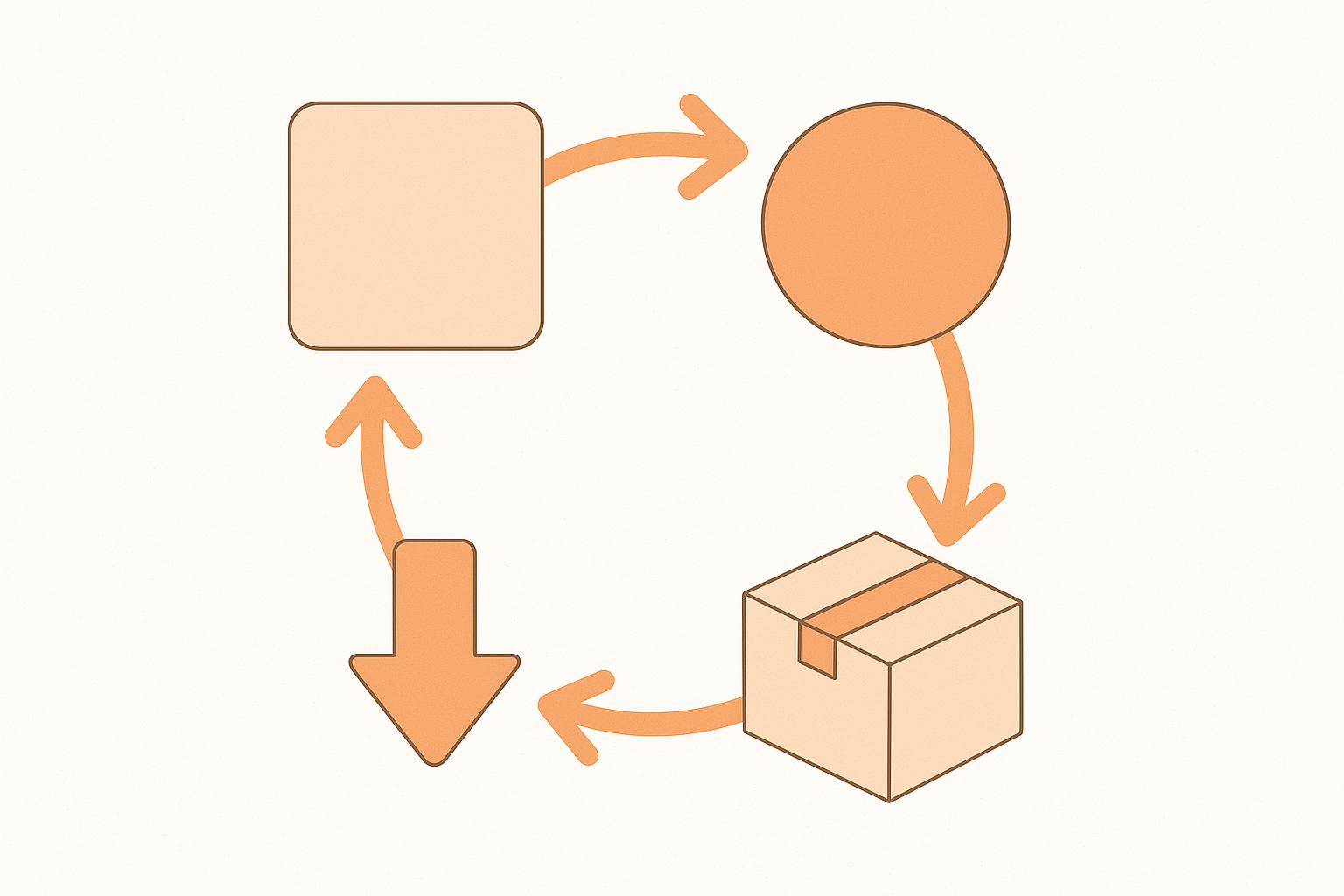How 3PLs Support Multi-Sourcing Strategies

E-commerce businesses are increasingly turning to multi-sourcing strategies to reduce risks and improve supply chain reliability. Instead of relying on a single supplier, multi-sourcing involves working with multiple suppliers for the same product or service. While this approach offers flexibility and protection against disruptions, it can be complex to manage. That’s where third-party logistics (3PL) providers come in.
Key Highlights:
- Multi-sourcing reduces risks like production delays or natural disasters by diversifying suppliers.
- 3PLs simplify supplier management by coordinating shipments, standardizing processes, and ensuring consistent quality.
- Technology is critical: 3PLs provide real-time inventory tracking, delivery synchronization, and centralized visibility across suppliers.
- Scalability: 3PLs adjust resources to handle seasonal demand, new product lines, or geographic expansion.
- Global reach: Their warehouse networks allow faster delivery and reduce shipping costs.
- Risk management: 3PLs create backup plans and monitor supply chain performance to address disruptions effectively.
Executing the Vision: The Role of 3PLs in Modern Supply Chains
Main Benefits of Using 3PLs for Multi-Sourcing
Managing multiple suppliers can be a complex task, but partnering with third-party logistics (3PL) providers simplifies the process. These partnerships bring essential advantages, making it easier and more profitable for e-commerce businesses to handle multi-sourcing strategies.
Scalability and Flexibility
One standout benefit of working with 3PLs is their ability to adjust quickly to your business's changing needs. When you're juggling multiple suppliers, demand can swing dramatically due to seasonal trends, new product launches, or sudden shifts in the market. 3PLs can handle these fluctuations without requiring you to hire extra staff, expand warehouse space, or invest in costly technology upgrades.
By partnering with a scalable 3PL, your business can grow without missing a beat. Whether you're dealing with higher order volumes, adding new product lines, or expanding operations into new regions, 3PLs can adapt by tweaking their processes, staffing, and technology. This kind of flexibility is particularly critical when you're managing multiple suppliers across different logistics providers.
Using multiple 3PLs also offers a safety net. If one provider encounters delays or quality issues, others can step in to keep things running smoothly. To make the most of this, look for 3PLs with strong warehouse networks spread across various regions. This geographic reach not only reduces shipping costs and delivery times but also supports your business as it scales. Providers with modular workflows - offering services like custom packaging, kitting, and bundling - can handle spikes in demand and complex business models with ease.
This adaptability is further strengthened by their expansive fulfillment networks.
Nationwide and Global Fulfillment Networks
3PL providers typically operate large networks of warehouses and fulfillment centers, covering multiple regions or even spanning the globe. This extensive reach is a game-changer for multi-sourcing, especially when your suppliers are scattered across different areas but your customers expect fast delivery, no matter where products originate.
With a broad fulfillment network, inventory can be strategically positioned closer to your customers. This reduces the need for costly expedited shipping and ensures faster delivery times, which in turn enhances customer satisfaction. Additionally, these networks provide built-in redundancy, offering a reliable way to navigate disruptions in the supply chain.
Real-Time Inventory Visibility
Another key advantage of 3PLs is their ability to provide real-time inventory tracking. Managing stock from multiple suppliers can be overwhelming, but modern 3PL technology platforms offer live updates, giving you a clear view of your supply chain at any moment. This level of visibility allows you to make smarter decisions about restocking, order fulfillment, and evaluating supplier performance.
Many 3PL systems integrate data from all your suppliers into a single, unified platform. This consolidated view helps you spot potential stockouts early, allocate inventory based on demand trends, and assess which suppliers are meeting expectations. Armed with this information, you can negotiate better terms, respond quickly to market changes, and address supply disruptions before they escalate.
Key 3PL Services for Multi-Sourcing Management
When managing multiple suppliers, the challenges can quickly add up - different shipping schedules, packaging standards, and product specifications can complicate operations. This is where specialized third-party logistics (3PL) services step in, offering solutions that go well beyond basic warehousing and shipping. These services are designed to streamline multi-sourcing and ensure your supply chain runs like a well-oiled machine.
Custom Logistics Solutions
Dealing with multiple suppliers requires logistics services that are flexible and adaptable to varying needs. 3PLs provide tailored solutions, such as customized transportation, warehousing, and fulfillment services, to meet these demands.
Take JIT Transportation as an example. They offer a suite of custom solutions, including transportation, distribution, and fulfillment, as well as specialized services like pick & pack, kitting & assembly, testing, and white glove handling. These services allow businesses to merge diverse supply streams into a single, coordinated fulfillment process.
The real benefit here? Consistency. Even if your suppliers have different practices, your customers won’t notice. Products are processed, packaged, and shipped according to your brand’s standards - not the suppliers’. This ensures a smooth and uniform customer experience, while also paving the way for seamless integration with advanced technology systems.
Integrated Technology Systems
Managing multiple suppliers without a unified system can quickly spiral into chaos. Modern 3PLs offer advanced technology platforms that connect systems like Enterprise Resource Planning (ERP), inventory management, and returns processing into one cohesive network.
For instance, if Supplier A ships to a 3PL's East Coast facility while Supplier B delivers to the West Coast, the platform automatically updates inventory levels, adjusts fulfillment routes, and keeps stock counts accurate across all locations.
These platforms also enable automated decision-making. Orders are routed to the most efficient fulfillment center based on factors like inventory availability, proximity to the customer, or shipping costs. This automation not only minimizes errors but also ensures your multi-sourcing strategy runs smoothly without requiring constant oversight.
Returns processing becomes a lot easier, too. When a customer sends back a product, the system can trace it to the original supplier, identify the best restocking location, and update inventory levels across all connected systems - all in real time.
Vendor-Managed Inventory and Dynamic Resource Allocation
In addition to custom solutions and integrated systems, 3PLs offer vendor-managed inventory (VMI) and dynamic resource allocation to further simplify multi-sourcing. With VMI, the 3PL takes charge of maintaining optimal inventory levels for each supplier, forecasting demand, and coordinating directly with suppliers to ensure stock is always available.
Dynamic resource allocation ensures that warehouse space, labor, and transportation resources are adjusted in real time based on supply fluctuations. For example, if Supplier A delivers a large shipment that needs immediate attention while Supplier B's delivery is delayed, the system reallocates resources to handle the urgent shipment without disrupting overall operations.
This approach also allows 3PLs to scale resources up or down based on demand. If one supplier’s products are in high demand, more warehouse space and staff can be allocated to process those shipments, while resources for less active suppliers are scaled back. The result? A responsive and cost-efficient supply chain that adapts to changing market conditions without requiring constant intervention.
With JIT Transportation's robust infrastructure and advanced technology, businesses can take advantage of these dynamic capabilities across a nationwide network. Whether suppliers are located near or far, these services ensure resources are allocated efficiently, keeping your supply chain in sync with customer demand.
Risk Management and Backup Planning with Multi-Sourcing
Supply chain disruptions can strike unexpectedly - whether it’s a natural disaster, port closure, supplier bankruptcy, or even a global pandemic. Managing these risks becomes more challenging when relying on multiple suppliers. That’s where third-party logistics providers (3PLs) come in. They turn potential weak points into strengths through effective risk management and backup planning.
Reducing Supply Chain Risks
The beauty of multi-sourcing is in its ability to spread risk. By diversifying inventory across different suppliers, regions, and routes, businesses reduce their vulnerability to disruptions. A skilled 3PL plays a crucial role here, monitoring key metrics like on-time delivery, quality, and capacity, while keeping an eye on external factors such as weather events, geopolitical tensions, and transportation issues. This proactive approach allows them to flag potential problems before they escalate.
3PLs also handle the complexities of regional logistics, coordinating shipping patterns and navigating regulatory differences. By continuously analyzing sourcing patterns, they ensure no single supplier becomes a weak link, helping maintain a resilient and adaptable supply chain.
Creating Backup Plans
When disruptions hit, having a solid backup plan is essential. This is where 3PLs shine, thanks to their established infrastructure and strong relationships with carriers. They’re experts at crafting and executing contingency strategies to keep operations running smoothly.
Take inventory redistribution, for example. If a supplier on the West Coast experiences delays, a 3PL can quickly shift orders to inventory stored in facilities elsewhere, ensuring customer orders still ship on time. Additionally, their network of alternative carriers ensures seamless transitions when primary shipping partners encounter delays.
Cross-docking capabilities add another layer of flexibility. If shipments are delayed at one location, 3PLs can reroute them in real time to other facilities for immediate processing and delivery. These strategies ensure the supply chain keeps moving, even in the face of unexpected challenges.
JIT Transportation as an Example

JIT Transportation illustrates how comprehensive 3PL services can bolster risk management in multi-sourcing setups. With a nationwide network and strategically located warehouses, they ensure that regional disruptions don’t derail operations. Their advanced technology provides real-time visibility into inventory and performance, enabling rapid activation of backup plans.
Their scalable infrastructure can handle major shifts in fulfillment needs without compromising quality. Services like pick & pack, kitting & assembly, and testing further ensure consistent standards across multiple suppliers.
sbb-itb-eafa320
Single-Sourcing vs. Multi-Sourcing with 3PL Support
When it comes to managing supply chains, the choice between single-sourcing and multi-sourcing can significantly influence your operations and growth trajectory. Both strategies come with distinct advantages and challenges, and the role of third-party logistics (3PL) providers varies depending on the approach you choose.
Single-sourcing relies on one main supplier, offering simplicity and lower upfront costs. On the other hand, multi-sourcing involves working with multiple suppliers, which increases flexibility and reduces risk.
Comparing Advantages and Disadvantages
To better understand how each strategy works with 3PL support, let’s break down their differences across key business factors:
Single-Sourcing with 3PL
- Risk Level: Higher vulnerability to disruptions; 3PL offers limited backup options from the single supplier
- Cost Structure: Lower procurement costs, simpler 3PL fees, and reduced administrative overhead
- Operational Complexity: Streamlined operations, easier 3PL integration, and simplified inventory management
- Scalability: Limited by the capacity of a single supplier; 3PL can optimize distribution but not sourcing
- Delivery Speed: Predictable lead times and efficient routing
- Quality Control: Easier to maintain consistent standards with a single supplier
Multi-Sourcing with 3PL
- Risk Level: Lower risk through supplier diversification; 3PL manages multiple supply streams and backup plans
- Cost Structure: More complex procurement; requires advanced 3PL support to optimize costs
- Operational Complexity: Requires coordination across multiple suppliers, adding complexity
- Scalability: High scalability; 3PL can dynamically adjust capacity across multiple suppliers
- Delivery Speed: Variable setup times, but 3PL optimizes routes for faster fulfillment from multiple locations
- Quality Control: More challenging; 3PL must coordinate quality across multiple suppliers
These comparisons highlight how 3PLs adapt their services to fit the demands of each sourcing strategy, balancing simplicity with flexibility and risk management.
Single-sourcing is often the go-to option for businesses dealing with specialized products, long-standing supplier relationships, or stable markets. In these cases, 3PLs streamline distribution, reduce administrative costs, and simplify operations. However, the lack of supplier diversity can pose risks during disruptions.
In contrast, multi-sourcing is better suited for businesses operating in volatile markets, those with seasonal demand, or when geographic diversification is necessary. Here, 3PLs become strategic partners, managing complex supplier networks and leveraging advanced technology to coordinate operations. While this approach requires a higher upfront investment in 3PL services, it offers greater flexibility and resilience, which can lead to significant savings during unexpected challenges.
The Role of Technology
The technology requirements for these strategies differ as well. Single-sourcing typically requires basic tools, such as warehouse management and transportation systems. Multi-sourcing, however, demands more sophisticated solutions, including inventory visibility tools, supplier performance tracking, and dynamic allocation systems. These technologies enable 3PLs to optimize operations and respond quickly to changes in supply or demand.
Cost Considerations
Costs go beyond just supplier pricing. Multi-sourcing often involves higher 3PL service fees due to the added complexity. However, this approach can lead to better overall cost efficiency. For example, a 3PL can shift orders to the most cost-effective supplier based on factors like pricing, capacity, and shipping expenses. While single-sourcing offers predictable costs, it lacks these optimization opportunities.
Ultimately, the decision between single-sourcing and multi-sourcing depends on your business goals. If simplicity and cost control are your top priorities, single-sourcing with basic 3PL support might be the best fit. But if you value growth, flexibility, and risk management, multi-sourcing with comprehensive 3PL services can deliver stronger long-term benefits, even if it involves more complexity and a higher initial investment.
Best Practices for Multi-Sourcing with 3PLs
Implementing a multi-sourcing strategy with the help of a 3PL (third-party logistics) provider requires careful planning and execution. Managing multiple suppliers while maintaining efficiency is no small feat. A structured approach that aligns with your business goals, partner selection, and communication strategies is key.
Evaluating Your Supplier Diversification Needs
Before jumping into multi-sourcing, take a step back to evaluate the vulnerabilities in your current supply chain. Identifying weak points will help you decide how much diversification is necessary. Start by analyzing your product lineup to determine which items are at risk of supply disruptions. Products tied to a single supplier, those with long lead times, or those with seasonal demand are often the most susceptible.
Consider your supplier distribution across regions, product categories, and their impact on revenue. If most of your suppliers are concentrated in one area, you're exposed to risks like natural disasters, labor disputes, or regulatory shifts in that region.
Your order volume and frequency also play a role. High-volume, consistent orders might make multi-sourcing a smart move, while low-volume specialty items may not justify the added complexity. Weigh the potential cost of supply disruptions against the investment required to diversify your suppliers to find the right balance.
For seasonal businesses, multi-sourcing can be especially useful. During peak periods, having multiple suppliers ensures you can handle demand surges without overburdening one partner. In slower months, you can adjust order volumes across your supplier network while maintaining relationships. These insights will guide you in selecting a 3PL that can effectively support your multi-sourcing strategy.
Choosing the Right 3PL Partner
The success of your multi-sourcing strategy hinges on choosing the right 3PL partner. Technology integration should be at the top of your checklist. Your 3PL must have systems that connect seamlessly with multiple suppliers, offering real-time updates on inventory, order status, and performance metrics across your network.
Look for 3PLs with a proven track record in managing multi-sourcing operations. Ask about their experience with clients who rely on multiple suppliers. Can they handle challenges like coordinating supplier relationships, managing quality differences, and optimizing order allocation based on cost, capacity, and delivery needs?
Your 3PL’s facility network also matters. It should streamline inbound logistics from various suppliers while ensuring efficient outbound shipping to your customers. This setup directly affects your logistics costs and delivery times.
Flexibility and scalability are crucial as well. As your business grows or your supplier network evolves, your 3PL should be able to adjust warehouse space, transportation capacity, and tech resources to meet your changing needs.
Take JIT Transportation, for example. Their nationwide network and advanced technology systems make them well-equipped to handle the complexities of multi-supplier logistics, from managing inbound shipments to providing the visibility required for smooth operations.
Lastly, don’t overlook the financial stability and reliability of your 3PL. Multi-sourcing often involves higher service fees and complex contracts. Ensure your partner has the financial resources to invest in the necessary technology and infrastructure to support your long-term goals.
Setting Up Communication Protocols
Once you’ve selected a capable 3PL, establishing clear communication protocols is essential for making multi-sourcing work smoothly. Without structured processes, coordinating between suppliers, your 3PL, and your internal teams can quickly spiral into chaos, leading to errors, delays, and higher costs.
Start by implementing standardized data formats for all supplier communications. This includes purchase orders, shipping updates, inventory reports, and quality checks. Consistent formats make it easier for your 3PL to compile and share unified reports across your supplier network.
Set up real-time information sharing to keep everyone informed of critical updates. Automated notifications for inventory changes, shipping delays, or quality issues can help you stay ahead of problems. Your 3PL should act as the central hub for this information, translating supplier-specific data into actionable insights for your team.
Develop escalation procedures to address issues like quality defects, capacity shortages, or shipping delays. Clearly define roles and responsibilities so that problems are resolved quickly and efficiently. Your 3PL should have direct access to key supplier contacts and the authority to make decisions within agreed-upon parameters.
Establish performance reporting standards to maintain accountability. Regularly track metrics like on-time deliveries, quality scores, and cost efficiency. Your 3PL should consolidate this data into reports that help you evaluate supplier performance and make informed decisions.
Finally, hold regular review meetings with your 3PL and key suppliers to ensure everyone stays aligned. These meetings should cover operational performance, upcoming challenges, and opportunities for improvement. A mix of monthly operational reviews and quarterly strategic planning sessions often works well.
To keep everything organized, create a supplier handbook that outlines expectations, procedures, and contact details. Update this document regularly and ensure all parties have access to the latest version. Your 3PL can assist in maintaining and distributing this handbook as processes evolve.
Conclusion: Why 3PLs Matter for Multi-Sourcing Success
For e-commerce brands striving to stay competitive and adaptable, multi-sourcing has become more than a strategy - it's a necessity. But juggling multiple suppliers, managing inventory from various sources, and ensuring seamless customer service can quickly overwhelm even the most seasoned operations teams. That’s where third-party logistics (3PL) providers step in, not just as service providers, but as essential partners.
A capable 3PL brings advanced technology to the table - tools that track inventory in real time, automatically allocate orders based on availability and cost, and provide unified reporting. Building such systems internally can be prohibitively expensive, making a strong 3PL partnership a smarter, more efficient choice.
The value of a 3PL extends beyond technology. They play a critical role in managing risks, especially during disruptions like pandemics, natural disasters, or geopolitical conflicts. With a solid multi-sourcing strategy backed by a reliable 3PL, businesses can maintain operations during crises and avoid the devastating impact of stockouts.
The financial advantages of partnering with a 3PL go beyond cutting costs. While multi-sourcing can lower per-unit costs by encouraging supplier competition, the real payoff comes from avoiding stockouts, minimizing excess inventory, and optimizing shipping expenses across a complex supplier network. A skilled 3PL uses real-time data to make dynamic sourcing adjustments, delivering flexibility that static contracts simply can’t match.
Scalability is another major benefit. As your business grows - whether by adding suppliers or expanding product lines - you won’t need to invest in building new internal capabilities. Your 3PL can handle the onboarding of new suppliers, integrate their systems, and ensure you maintain the visibility and control you need. Companies like JIT Transportation exemplify how the right 3PL partnership can turn multi-sourcing into a competitive edge. With nationwide infrastructure, advanced tech integration, and adaptable services, they help e-commerce brands execute complex sourcing strategies without the usual operational headaches.
FAQs
How do 3PL providers simplify managing multiple suppliers in a multi-sourcing strategy?
Third-party logistics (3PL) providers play a crucial role in simplifying the complexities of multi-sourcing strategies. They offer centralized coordination and real-time visibility, making it easier to track inventory and manage split orders without a hitch.
Beyond just logistics, 3PLs help businesses minimize risks by spreading sourcing across different regions, reducing dependency on a single supplier or location. With their advanced technology and scalable infrastructure, they can handle even the most intricate supply chain networks, ensuring everything runs smoothly and deliveries stay on schedule.
For companies in the United States, 3PLs often deliver customized services like transportation, fulfillment, and even specialized options such as kitting and assembly. These tailored solutions cater directly to the unique challenges of multi-sourcing strategies, giving businesses the flexibility they need to succeed.
How do 3PL providers use technology to ensure real-time inventory tracking and seamless operations with multiple suppliers?
Third-party logistics (3PL) providers use cutting-edge tools like Warehouse Management Systems (WMS) and Inventory Management Systems (IMS) to keep inventory operations running smoothly and provide real-time updates. These systems often incorporate technologies such as RFID, IoT sensors, and real-time analytics, making it easier to track stock across multiple warehouses and suppliers.
With these tools in place, 3PLs can oversee inventory movement, fine-tune order routing, and facilitate seamless transfers between suppliers. This approach not only keeps supply chains efficient but also helps businesses maintain precise stock levels while ensuring customer orders are fulfilled quickly and reliably.
How do 3PL providers help reduce risks and handle disruptions in a multi-sourcing supply chain?
Third-party logistics (3PL) providers play a key role in reducing risks and handling disruptions in a multi-sourcing supply chain. One way they achieve this is by maintaining buffer inventories of essential products. This ensures a steady supply, even when unexpected delays or interruptions occur, helping businesses keep sales on track and customers happy.
On top of that, 3PLs leverage advanced technology to keep a close eye on potential risks throughout the supply chain. By pinpointing weak spots and identifying areas prone to disruption, they help businesses put preventative measures in place. Regular risk evaluations and well-thought-out contingency plans add an extra layer of protection, ensuring operations stay smooth and efficient, even when challenges arise.
Related Blog Posts
Related Articles

How to Track Reverse Logistics Metrics

Best Practices for Renewable Energy in 3PL Operations

